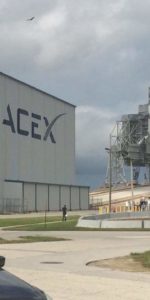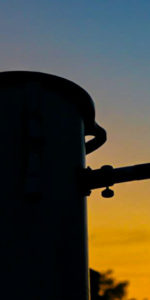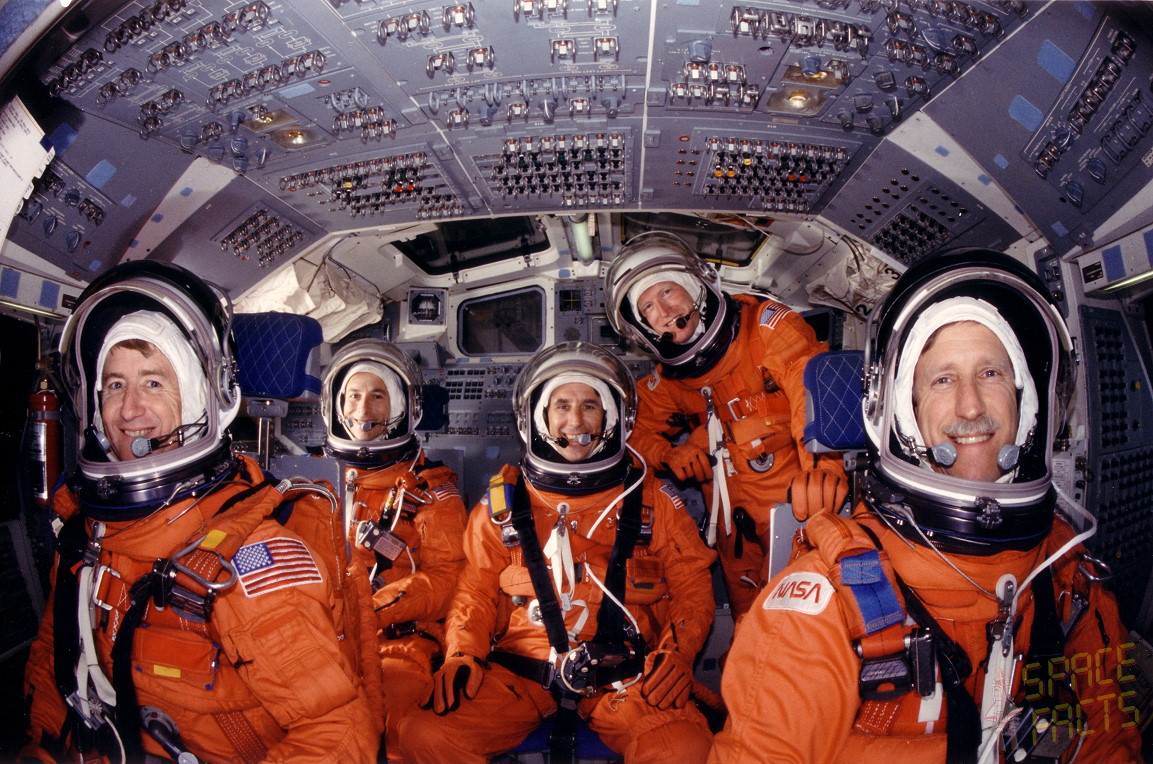
A quarter-century ago, the world stood on the brink of outright conflict in the Middle East, following the August 1990 invasion of Kuwait by the Iraqi dictator, Saddam Hussein. Against this stormy backdrop of an impending war which would define a generation, as well as set the groundwork for later assaults on Iraq and the eventual overthrow of Saddam, in November 1990—25 years ago, next week—Atlantis rocketed into orbit on the seventh classified shuttle mission for the Department of Defense. To this day, the exact details of what the five-man STS-38 crew did during their five days in orbit remain enshrouded in secrecy. But as with so many aspects of these classified missions, real events and rumors have become strangely juxtaposed and there can be little doubt that it will be many more years before any hard facts about this mysterious flight see the light of day.
As outlined in a previous AmericaSpace series of articles, available here and here, STS-38 was originally targeted for launch in May 1990, but fell victim to a fleetwide series of hydrogen leaks which plagued Atlantis and Columbia. Its crew—Commander Dick Covey, Pilot Frank Culbertson, and Mission Specialists Charles “Sam” Gemar, Bob Springer, and Carl Meade—were announced by NASA on 11 May 1989 and entered a standard 12-month training regime. Springer had flown one previous mission, and Covey two, whilst their crewmates were all embarking on their first flights. For Covey, the assignment did not come as a complete surprise, for in early 1989 he had replaced Brewster Shaw as the Astronaut Office’s lead representative on the DoD shuttle missions. In spite of its relatively benign appearance on paper, the assignment exposed Covey to the innermost details of the most secret missions ever undertaken by the shuttle fleet.
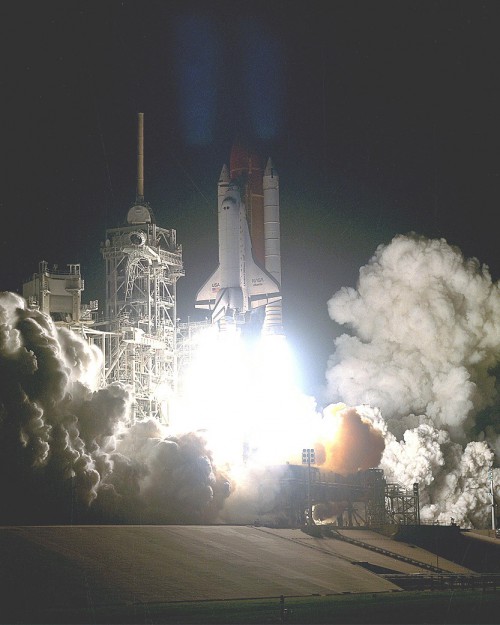
The insights to which Covey was privy were far higher than those of his fellow astronauts, who had been assigned to missions. “Each crew was read-into the particular DoD program that they were supporting,” he told the NASA oral historian, “but there needed to be someone who was aware of what all of those missions were going to be doing and working that interface with the appropriate agencies within the DoD to make sure that the crew issues that may cross all of those were being taken care of.” Covey’s role was to manage the classified materials and the staff, whose involvement demanded a level of security clearance beyond “Top Secret.” Many of his meetings were held in “special environments” and the importance of his role was underlined by the fact that even the astronauts for one DoD mission did not always know what their fellow astronauts, assigned to another DoD mission, might be working on. From STS-27 in December 1988 until his own flight, two years later, Covey was thus involved with some of the most tantalizing missions ever flown in the U.S. human spaceflight program.
In fact, Covey had been undecided after his second shuttle voyage—STS-26, the post-Challenger Return to Flight (RTF) mission, in September 1988—about whether to remain with NASA or return to his military career. “I was approached … about returning to an Air Force assignment as a Test Wing Commander over at Eglin Air Force Base,” he told the NASA oral historian. “Going through the process of making my decision on whether I wanted to accept their offer to come back to a very good job or to stay and fly again, I had discussions with [then-Chief of the Astronaut Office] Dan Brandenstein about what’s going to happen next. In that discussion with Dan is when he told me of his intent for me to fly STS-38.” With this assignment, the DoD lead representative job made more sense. “Brewster left and went off and flew one of the DoD missions … and so I kind of rolled in behind him in doing that.”
As their training progressed, and the shuttle manifest contorted its way through the first full year after the post-Challenger RTF, it became clear that STS-38 would launch no sooner than mid-summer, with Atlantis having touched down at Edwards Air Force Base, Calif., on 4 March, to wrap up the STS-36 classified mission. Returned from the West Coast to Florida atop the Boeing 747 Shuttle Carrier Aircraft (SCA), the vehicle was rolled into the Orbiter Processing Facility (OPF) at the Kennedy Space Center (KSC) on 14 March and underwent a comparatively smooth effort to ready her for STS-38. On 8 June, Atlantis moved into the cavernous Vehicle Assembly Building (VAB) for stacking onto her bulbous External Tank (ET) and twin Solid Rocket Boosters (SRBs). Ten days later, she was transferred out to Pad 39A, tracking an opening launch attempt in mid-July.
Unfortunately, her sister ship, Columbia, had suffered a series of seemingly inscrutable hydrogen leaks from the 17-inch-diameter (43 cm) disconnect fitting. This hardware, located on the orbiter’s belly, allowed liquid oxygen and hydrogen from the ET to enter the aft compartment and power the cluster of three Space Shuttle Main Engines (SSMEs). Shortly after the STS-38 stack reached the pad, NASA opted to perform a “tanking test” to verify that Atlantis was not affected by the same problem. Two methods of propellant-loading were followed: an initial “slow-fill” chilled down the pipework in her aft compartment and tank structure, in order to preclude the risk of boiling and the generation of excessive quantities of gas, followed by a higher-rate “fast-fill.”
On 29 June, liquid hydrogen was pumped into Atlantis’ ET and, to engineers’ dismay, small concentrations of gas were detected in the vicinity of the disconnect hardware when the fueling process moved from the slow-fill into the fast-fill modes. According to NASA, the problem was “both temperature- and flow-rate-dependent,” but conviction was expressed that the simultaneous leaks in Columbia and Atlantis were purely coincidental. A second tanking test was performed on 13 July, after which sealants were added to halt the leak, but a third test on 25 July revealed that it continued. Two weeks later, on 9 August—in one of the most enduring images ever taken during the 30-year shuttle program—the STS-38 stack was rolled back from Pad 39A to the VAB, passing the STS-35 stack, as Columbia made her way back out to the launch complex.
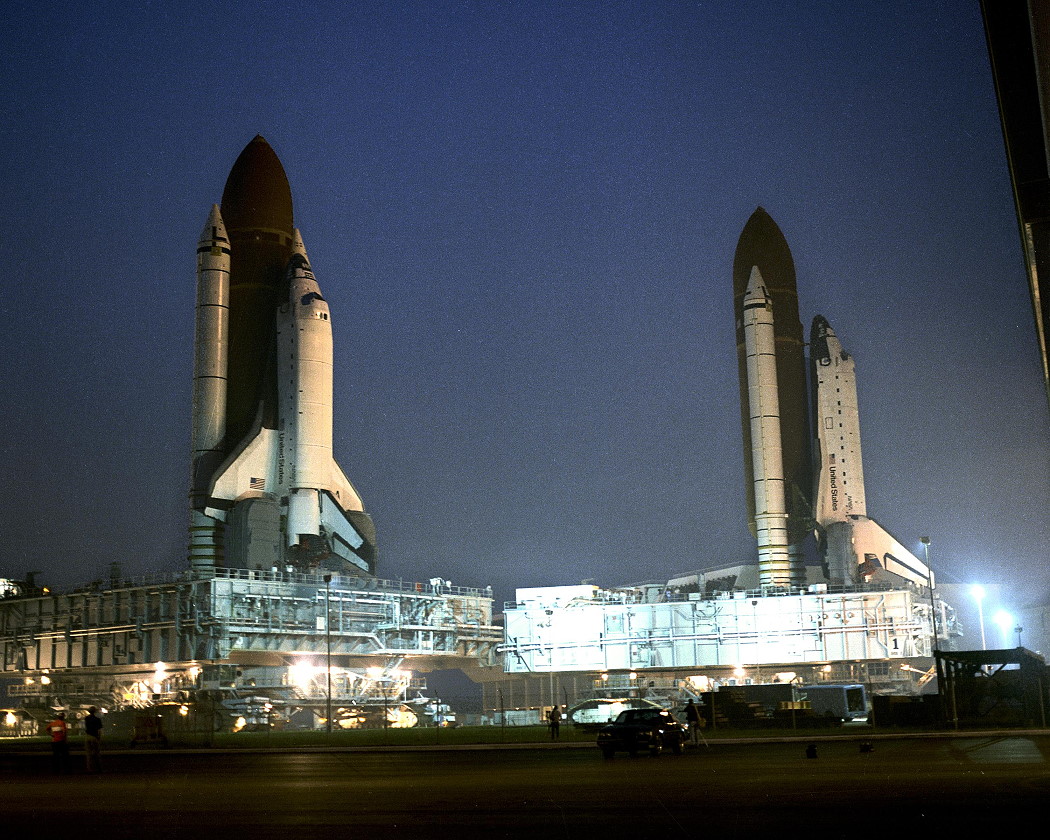
Back in the assembly building, Atlantis was destacked from her ET/SRBs and returned to the OPF on 15 August for attention to her hydrogen leakage issues. At length, she was back on Pad 39A by 12 October and promptly sailed through a tanking test, with NASA confidently scheduling STS-38 to fly no sooner than 9 November. Problems with her DoD primary payload enforced a slight delay until the 15th, with media being informed only that the launch would occur during a four-hour “window” from 6:30 through 10:30 p.m. EST. In spite of fears of high winds at the Shuttle Landing Facility (SLF)—to be used in the event of a Return to Launch Site (RTLS) abort—which initially placed estimates of acceptable weather at just 40 percent, conditions improved to 70-percent favorable and Atlantis speared into orbit at 6:48 p.m., turning night into day across the Space Coast.
“Liftoff of Atlantis,” came the call from the Public Affairs Officer (PAO), “and the crew of a classified Department of Defense flight.”
In keeping with protocol on these secretive missions, all communications between the orbiter and the ground during the early stages of ascent—including Dick Covey’s “Roll Program” call at T+10 seconds and, later, acknowledgement of the engine-throttle-up call from Mission Control—were blacked-out. For Covey, launching in darkness presented few surprises; his first flight in August 1985 had begun on a cusp of daybreak and he was familiar with many of the sights and sounds and sensations involved. Most of Covey’s family was in attendance on the night that STS-38 launched, with the exception of his eldest daughter, Sarah, who was on the Clear Lake High School volleyball team, back in Houston, which had just won the region. She was on her way to Austin, Texas, to play in the state championship series and was on the bus when Atlantis roared into orbit. Throughout the flight, Covey would receive uplinked teleprinter messages to keep him aware of the scores.
The STS-38 crew represented all four “core” military services, with Covey and Meade from the Air Force, Culbertson from the Navy, Springer from the Marine Corps and Gemar from the Army and all were graduates of a military test pilot school. (In fact, both Springer and Meade had actually applied to NASA for both the Pilot and Mission Specialist categories.) However, flying with three “rookies” posed its own challenges. “The good news is that we weren’t flying a real long mission,” Covey told the NASA oral historian, years later, “so they didn’t have to worry about a whole lot of things. The bad news was that our most critical operations were all on the first day, right between launch and the time we went to bed; so these guys were going to be adapting to space for a first time, with all of the “gee-whiz” factors, and we had to do our most serious and significant work that first day in deploying a payload.”
As Atlantis settled into orbit on the evening of 15 November 1990, only hours before Carl Meade’s 40th birthday, the STS-38 crew was ready for four days of classified operations. By this stage, three months after Saddam Hussein’s annexation of Kuwait, a growing international military presence was taking shape in the Persian Gulf. Two days earlier, on 13 November, a Titan IV booster had roared into orbit from Cape Canaveral Air Force Station, carrying a Defense Support Program (DSP) infrared early-warning satellite, and there was great speculation that the payload to be deployed by Atlantis’ crew would be similarly directed toward intelligence-gathering over the Middle East. Little could the STS-38 crew have known, however, that their mission would end not at Edwards Air Force Base, Calif., but—for the first time since April 1985—back at their launch site in Florida.
– The second part of this article will appear tomorrow.
Be sure to “Like” AmericaSpace on Facebook and follow us on Twitter: @AmericaSpace
.




